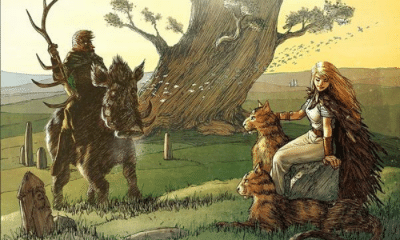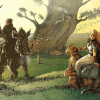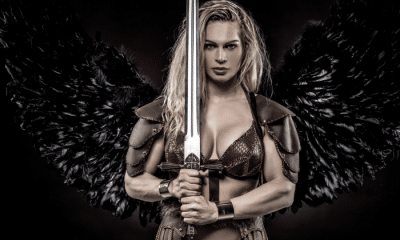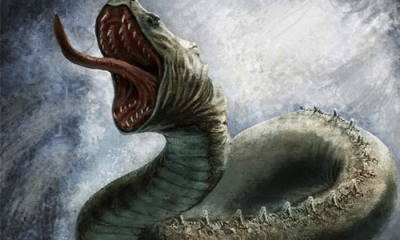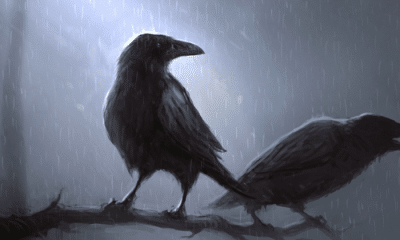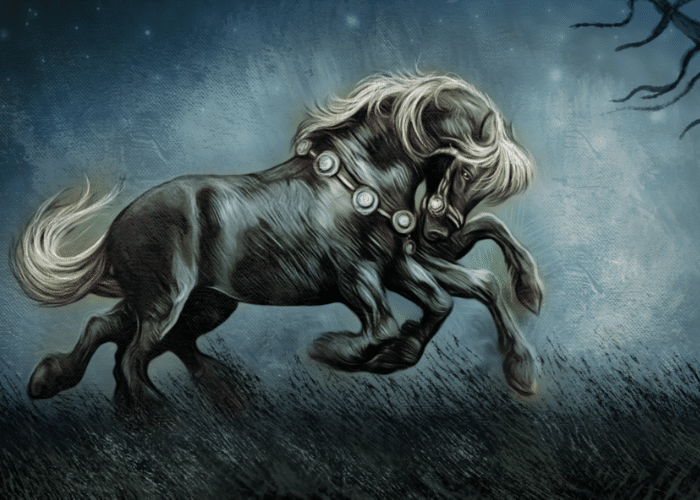
Norse
Sleipnir: Odin’s Eight-Legged Horse
Sleipnir: Odin’s Eight-Legged Horse
The magical eight-legged horse of Norse mythology is an iconic animal, but how much do you know about the legends of Sleipnir?
Many animals appear in Norse mythology, but few are as immediately recognizable as Sleipnir.
Odin’s supernaturally fast horse travels between worlds on eight legs. Usually shown as a large white stallion, Sleipnir is mentioned more often in written myths than many of the gods he lived among.
Sleipnir’s importance was not just in his speed and agility. It wasn’t even due to the unusual circumstances of his famous birth story.
Instead, Sleipnir was an important part of Norse mythology because of what he symbolized. Odin’s magical horse was a powerful symbol of his owner’s unique mastery of ancient magic.
How Odin Got Sleipnir
Sleipnir originated shortly after the war between the Aesir and Vanir gods ended. Asgard’s walls had been damaged, so the gods hired a builder to remake the fortifications.
The mason claimed that he could complete the work in a year without any help beyond the use of his horse, but his price horrified the gods. He demanded Freyja’s hand in marriage as his payment.
Freyja wanted to refuse the offer entirely, but Loki convinced the gods that the man’s task would be impossible.
They did not know that the workman was actually a jötunn, or giant, in disguise. His stallion, Svaðilfari, had supernatural strength and stamina as well.
The seemingly humble builder was completing his work with almost unbelievable speed. Freya was horrified, and furious, to see that he might be able to finish the work before the year was up.
Loki, however, would ensure that the work was not finished. He knew that he would be blamed if Freyja were forced to marry a jötunn mason.
Loki was a shapeshifter, and only a few days before the builder’s year was up he took the shape of an exceptionally well-formed mare. He ran around the fields outside of Asgard until Svaðilfari noticed him.
The stallion ran after the mare and the two horses were not seen for several days. The jötunn worked until he nearly collapsed from exhaustion, but without his horse to pull stones and pulleys the work was impossible.
At the end of the final day of the agreed year, a few stones were left to be fitted into the wall. Asgard’s walls were nearly finished but the gods did not have to pay for the work.
When the builder learned that he had lost, he grew angry and revealed his true form. According to many sources, Thor killed him with a blow from his hammer for attempted to defraud Freyja into marriage.
The matter of Asgard’s walls was settled, but the gods soon realized that Loki still had not returned. It would be several months until they saw him again.
When Loki finally returned to Asgard he brought a new horse and presented it to Odin as a gift. Loki had become pregnant by the jötunn’s horse and during his time away from the gods had become the animal’s mother.
The horse was named Sleipnir and it was immediately clear that it was not an ordinary horse. It had eight legs that allowed it to run faster than any creature or vessel in the Nine Worlds.
Odin used this ability several times in written legends. In one, a jötunn named Hrungnir attempts to kill him but he is able to use Sleipnir’s amazing speed to escape back to Asgard.
Sleipnir’s name meant “slippery,” and he lived up to it. He could not only traverse any surface, but could also travel between realms as easily as a normal horse traveled down a road.
Although the gods mocked Loki for being a mother, Odin son became quite fond of the trickster’s unusual child. Only once did he allow someone else to ride his best horse.
When Baldr was killed, Odin lent Sleipnir to Hermoðr for his journey to Hel. Even with the horse’s incredible speed, it still took Hermoðr over nine days to reach the gates of Hel to bed for Baldr’s release.
My Modern Interpretation
Sleipnir may seem like an incredible and unique animal, but he is actually one of several eight-legged horses of the ancient world.
These are not limited to folklore from the same region. Scholars have found similar animals in the legends and archaeology of India’s Gondi people, the Buryats of Siberia, and the stories of Hungary’s táltos shamans.
One thing all these horses have in common is the ability to somehow transcend realms, specifically in traveling to the land of the dead.
In India, for example, the Gondi sing a song at the funerals of their leaders telling them to mount the eight-legged horse Bagri Maro. In Hungary and Eastern Russia, the animals are the familiars of shamans and take them between worlds when they practice magic.
Scholars therefore interpret Sleipnir as another example of an archetype that can be seen across the Indo-European world. One historian went so far as to say that horses with extra limbs are virtually ubiquitous in cultures that have an equestrian tradition.
Sleipnir is a shamanic totem animal. His extra legs to not only give him amazing speed, they also reveal the fact that he can use ancient types of magic to travel between realms.
The fact that Sleipnir was Odin’s mount is significant in this interpretation. He was not Odin’s only shamanic totem.
The chief of the Aesir gods was depicted as a powerful magic user. Many of his legends involved the great lengths he went to in order to learn secret knowledge about magic and fate.
In Old Norse this type of magic was called seidr. Most historians view seidr as a local variation on traditional shamanic practices.
As a wise shaman, Odin had several totemic animal companions that served different functions in his magic.
His wolves, Geri and Freki, symbolized his physical prowess. They kept him safe from physical threats and acted as constant guardians.
His most famous totem animals were his ravens, Huginn and Muninn. They represented his knowledge as they flew above the world and brought back news of everything they saw.
As a part of this totemic grouping, Sleipnir represented another aspect of Odin’s power. They represented his ability to travel between worlds to contact the dead and receive prophecies of the future.
Hermoðr’s journey was not the first time Sleipnir had been ridden to Hel. Odin himself made the trip before Baldr’s death to learn the secrets of a dead seeress.
The ability to travel to the land of the dead gave Odin otherwise impossible insight into the nature of fate. In Hel he learned what would happen at Rangarök and the events leading up to it, beginning with Baldr’s untimely death.
The knowledge the gods had about their fate was not only because of Odin’s search for knowledge and magic. It was also because he had Sleipnir, a shamanic animal that gave him the power to learn things no one else could.
In Summary
In Norse mythology, Sleipnir is a well-known horse with eight legs.
He was born, unusually, to a male deity. To avoid repaying one of his many dangerous bets, Loki took the form of a mare to distract a giant’s stallion and became pregnant by the horse.
When Sleipnir was born, Loki gave his foal to Odin. Sleipnir soon became the god’s favorite mount.
Sleipnir’s eight legs allowed him to run faster than any other animal. He could move over any surface as quickly and easily as if it were a smooth road.
More importantly for Odin, Sleipnir also had the ability to travel between worlds. Twice, the magical horse made the journey to Hel and he often took Odin to Asgard, Midgard, and the other Nine Worlds of Norse cosmology.
Some historians believe that this ability is the most important aspect of Sleipnir.
In other cultures, eight-legged horses are tied to shamanism. They allow their spiritual riders to travel between worlds in their rituals, specifically to the land of the dead.
Odin was a master of seidr, the shamanic magic of the Norse people. Like his other totemic animals, Sleipnir represented an aspect of the All-Father’s magical abilities and knowledge.


